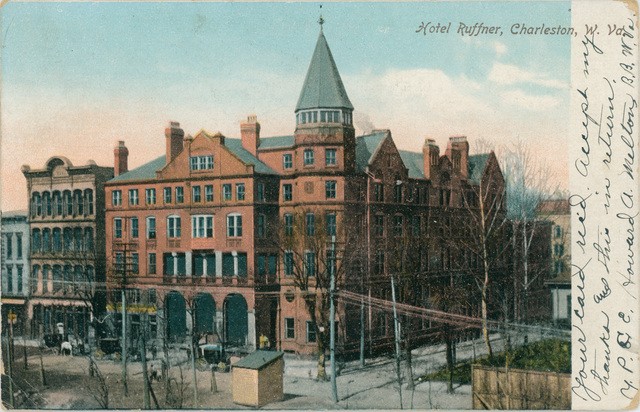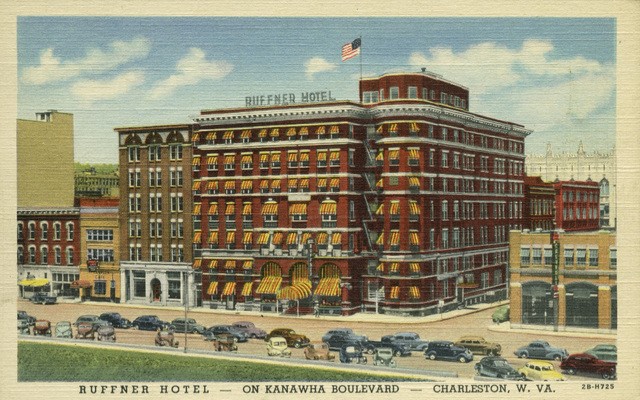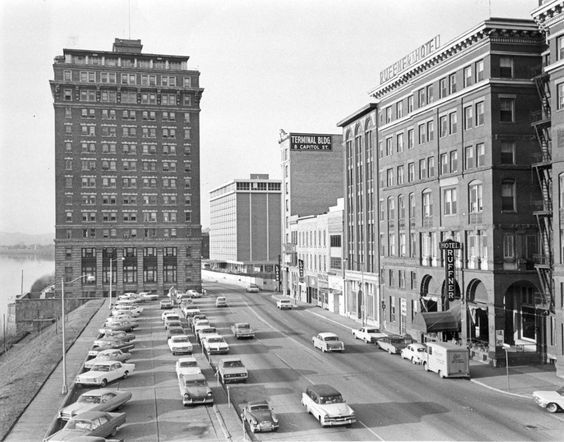Site of the Hale House and Ruffner Hotel (1872-1970)
Introduction
Text-to-speech Audio
Images
The original Hale House. 1872-1885

The original Ruffner Hotel, built in 1885 after the Hale House was destroyed by fire.

A 20th-century view of the Ruffner Hotel. Note that many of the Victorian flourishes are gone, replaced by a more modern silhouette.

Kanawha Boulevard in 1967. Note the Ruffner Hotel at far right, only three years before it was demolished.

Dr. John P. Hale, one-time mayor of Charleston and owner of the Hale House.

Backstory and Context
Text-to-speech Audio
Dr. John P. Hale was a leading entrepreneur in Charleston's early years. He practiced medicine for four years before investing in the area's first extraction industry, the salt mining business. His capacity to secure credit allowed him to leverage his existing wealth and invest in real estate and salt mining. Hale helped form the Bank of the West and he also owned the first gas company in Charleston. At one time, he also controlled all the ferries in the city.1
Hale spearheaded the effort to move the state capital from Wheeling to Charleston. He also assisted in securing the finances for the project. Shortly after being elected Mayor of Charleston in 1871, Hale began construction of the Hale House. The Hale House was meant to be a grand hotel that would house state legislators during their stay in the capital. The hotel was the most expensive lodging area in the city at the time. It cost approximately $150,000 to build and opened in January, 1872. It boasted:
"100 bedrooms fitted up with elegance, a splendid office, bar and billiard room, barber shop and bathroom."2
After the hotel burned down in 1885, a new hotel was built on the site, owned by A.L. and Meredith Ruffner, who operated it until 1900. The new hotel was larger, containing at least 180 rooms.3 It was the largest building in Charleston aside from the capitol complex. The Ruffner Hotel featured a spire on one corner and a portico that faced Kanawha Street.
The South Side Bridge was built in 1891. It was the first bridge constructed across the Kanawha River. The downtown-Charleston entrance was located right at the hotel. The Ruffner had easy access to the C&O Railroad depot. It became an ideal spot for travelers to stay at.
As an operational hotel until 1970, the Ruffner Hotel played witness to many key events of the last century. In 1913, for example, in the midst of the West Virginia Mine Wars, the famed union organizer "Mother" Mary Jones was arrested in Charleston and held in the Ruffner Hotel before being put on a train taking her into military custody.4
The Ruffner's restaurant was noted for its fine dining in the 1950's. However, the hotel could no longer compete with extravagant hotels that had been built in the city during the late 1920's. The Ruffner Hotel was torn down in 1970 to make room for the present parking lot.
Sources
1. Andre, Richard A.. John P. Hale. The West Virginia Encyclopedia. November 29, 2012. Accessed August 31, 2017. https://www.wvencyclopedia.org/articles/114.
2. Morgan, John G.. Byers, Robert J.. Charleston 200. Charleston, WV. The Charleston Gazette, 1994. 82-83
3. Vintage West Virginia: The Ruffner Hotel. Charleston Gazette-Mail. December 18, 2016. Accessed August 31, 2017. http://www.wvgazettemail.com/vintage-photos/20161218/vintage-west-Virginia-the-ruffner-hotel.
4. "'Mother' Jones Arrested in City." Charleston Gazette(Charleston), February 14, 1913. http://www.wvculture.org/history/labor/motherjones03.html
Andre, Richard A. Ruffner Hotel, e-WV. October 1st 2013. Accessed July 8th 2020. https://www.wvencyclopedia.org/articles/140.
